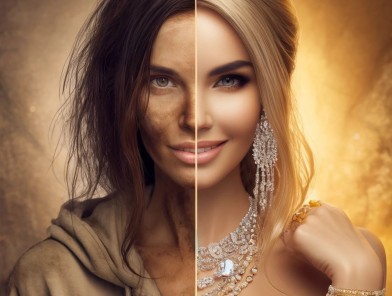Understanding Two Worlds That Often Overlap
The relationship between sex work and modelling has always been complex, layered with cultural stigma, aesthetic admiration, and social contradiction. Both industries are built around the human body, visual appeal, and desire yet they exist in very different social spaces. One is celebrated, commercialized, and openly monetized through art, fashion, and beauty; the other, while equally driven by market demand and personal expression, is often judged, misunderstood, or criminalized.
The intersection between modelling and sex work is not a coincidence but a reflection of deeper societal structures particularly the way female sexuality and beauty are commodified, controlled, and consumed. Modelling and sex work both revolve around presentation and perception: how a person appears, how they make others feel, and how that emotional or aesthetic connection is exchanged for economic value. In both cases, there is an undeniable tension between empowerment and exploitation, freedom and judgment, glamour and risk.
The Historical Connection Between Beauty and Desire
To understand the modern overlap between modelling and sex work, it’s necessary to look back at how both professions evolved. In the early twentieth century, when the modelling industry began to formalize through fashion houses and photography studios, women were celebrated as muses living canvases for designers and artists. Yet beneath the surface of elegance and luxury, many of these same women navigated ambiguous professional boundaries.
Throughout history, there have always been women who blurred the line between muse, model, and courtesan. During the Belle Époque and early Hollywood eras, famous actresses and models were often rumored to have relationships with wealthy patrons, blurring the line between personal and professional association. Their beauty was both their livelihood and their vulnerability. The camera, much like the gaze of a client, became a medium through which desire, status, and power interacted.
In many ways, the modelling world normalized what sex work had long represented the monetization of allure. While one was socially praised and the other condemned, both involved using beauty, performance, and self-presentation to navigate a male-dominated economy of attention.
The Economic Parallels Between Modelling and Sex Work
The economic similarities between modelling and sex work are perhaps the most direct reason they often overlap. Both industries reward youth, beauty, and charisma, and both can offer extraordinary financial opportunities for those who rise to the top. However, the instability, competition, and exploitation risks are also strikingly similar.
Modelling, especially in its early stages, is often underpaid and inconsistent. Many young models are expected to work for “exposure” rather than income, or to accept unpaid shoots that promise future opportunities. The financial pressure and the uncertainty of success push some individuals to seek alternative ways to maintain their lifestyle or independence. Escorting or other forms of sex work can offer an immediate, controlled, and often far more lucrative income source one where the model remains her own business, manager, and brand.
The choice, in many cases, is not about desperation but autonomy. Some models turn to escorting because it provides financial stability without dependence on agencies or exploitative contracts. The skills overlap too: presentation, confidence, communication, and emotional intelligence all essential to both professions.
A Shared Focus on Image, Fantasy, and Performance
At the core of both industries lies the art of performance. Whether posing for a camera, walking down a runway, or meeting a client for dinner, both modelling and escorting involve creating an image a persona that blends authenticity with artifice.
Modelling teaches control: how to hold a pose, project emotion, and express confidence through subtle physical gestures. Escorting, similarly, requires emotional performance reading others’ moods, responding with empathy, and adapting to different personalities and social contexts. Both professions demand awareness, self-discipline, and the ability to maintain composure under scrutiny.
The fantasy element is also central. Fashion and advertising rely on illusion on selling not just clothing, but aspiration. Sex work, in its own way, does the same: it offers an experience, a moment of connection or escape, crafted around desire and imagination. The line between performance and authenticity becomes fluid, and in both worlds, success often depends on how convincingly one can blur that line.
Case Studies: When Modelling Meets Sex Work
There have been numerous public examples of individuals who have navigated both worlds, sometimes openly, sometimes discreetly. While discretion and privacy are central to both industries, a few cases have emerged where the overlap became public discussion.
One of the earliest and most controversial examples is Lolo Ferrari, a French model and entertainer whose career spanned glamour modelling, adult films, and sex work. Her persona embodied the blurred line between erotic performance and celebrity culture. Similarly, in more recent years, several models have gained notoriety for revealing escort or sugar arrangement experiences, often challenging public assumptions about what it means to sell one’s image versus one’s intimacy.
Another case is that of the British model and writer Brooke Magnanti, who became widely known as “Belle de Jour” after anonymously publishing her memoir The Intimate Adventures of a London Call Girl. Magnanti, a research scientist and model, revealed her escort work years later, sparking a global debate about the intellectual and emotional dimensions of sex work. Her story broke stereotypes, illustrating how the decision to work as an escort can coexist with education, ambition, and professionalism.
More recently, platforms like OnlyFans and Patreon have further blurred the boundaries between modelling, self-promotion, and sex work. Many professional models use these spaces to monetize exclusive content, crossing into erotic expression in ways that challenge traditional definitions. These platforms demonstrate that what once existed in secrecy is now part of a digital ecosystem of self-managed adult entrepreneurship.
The Role of the Internet in Blurring Boundaries
The rise of social media and digital marketing has dramatically changed the landscape for both modelling and sex work. Instagram, for example, has become one of the most powerful tools for self-branding yet it also functions as a visual marketplace of beauty and attention that closely mirrors the economics of desire.
Many models build their following by presenting polished, curated images that suggest accessibility without revealing intimacy. Sex workers, by contrast, often use similar imagery but monetize the emotional or erotic connection directly. The platforms are often the same, the difference lying only in the kind of access one sells public admiration or private experience.
The internet has also democratized both industries, allowing individuals to bypass agencies, gatekeepers, and middlemen. Independent escorts and freelance models now share the same tools photography, SEO, branding, and client management to maintain control over their careers. The digital age has therefore eroded much of the traditional divide, creating a more fluid space where beauty, intimacy, and commerce intersect seamlessly.
Stigma and Double Standards
Despite their many similarities, modelling and sex work are perceived very differently by society. One is framed as artistic, aspirational, and glamorous; the other, though often equally aesthetic and professional, is stigmatized as immoral or dangerous. This double standard reveals how society draws moral lines not by what someone does, but by how openly they do it.
A lingerie model may pose nearly nude for a campaign viewed by millions, yet face no stigma, while an escort offering private companionship even without explicit acts can be condemned. Both are forms of bodily presentation and both engage with desire, yet only one is accepted within social norms. The difference lies not in the action but in the label, the perception, and the cultural need to separate “art” from “sex.”
This stigma often drives secrecy, which in turn reinforces prejudice. Many models who have worked as escorts remain silent about it, fearing damage to their professional reputation or personal safety. This silence perpetuates the illusion that the two industries are entirely separate, when in reality they share far more common ground than society admits.
Empowerment, Exploitation, and Choice
A meaningful analysis of the link between sex work and modelling must also confront the central debate: empowerment versus exploitation. Critics argue that both industries objectify women, reducing them to commodities for visual or sexual consumption. Supporters, however, emphasize autonomy the ability to control one’s image, choose one’s clients, and capitalize on personal power.
In truth, both realities coexist. The line between empowerment and exploitation depends on context on who holds control, who benefits, and who sets the terms. A model managed by an exploitative agency may have less freedom than an independent escort managing her own business. Conversely, an escort working under coercion or economic desperation may experience less empowerment than a model enjoying creative agency. The moral binaries often fail to capture this nuance.
Feminist discussions around sex work and modelling increasingly recognize that both can serve as platforms of self-expression, provided the person involved exercises genuine consent and control. Both industries can be exploitative in their worst forms, yet they can also be liberating spaces for those who redefine beauty, sensuality, and independence on their own terms.
The Psychological and Emotional Dimensions
Another shared element between modelling and escorting is the emotional cost of constant visibility. In both professions, personal identity becomes intertwined with public image. A model’s self-esteem can depend on casting decisions, social media validation, or the opinions of photographers and agencies. Similarly, a sex worker’s confidence may fluctuate based on client feedback, emotional labor, and the ability to maintain composure in emotionally charged situations.
The pressure to remain “perfect” physically, emotionally, and socially can be immense. Both worlds require careful emotional boundaries. Burnout, anxiety, and self-doubt are common experiences, as is the challenge of separating one’s professional persona from personal identity.
Yet the resilience these professions demand often produces a profound self-awareness. Models and escorts alike develop a deep understanding of human behavior, of what people desire, fear, and project. Many who transition out of these industries later succeed in fields like coaching, photography, writing, or therapy, because they understand human complexity at a level few others do.
Public Perception and Media Narratives
Media representation plays a crucial role in how society perceives both professions. Fashion photography romanticizes the human form, while adult media often sensationalizes it. The line between admiration and moral judgment is thin the same aesthetic that sells perfume can also sell fantasy.
When models are revealed to have engaged in escorting or adult work, the public reaction is often hypocritical fascination mixed with moral outrage. This was evident in high-profile cases such as Italian model and television personality Nina Moric, who spoke openly about the financial and emotional challenges faced by women in modelling and entertainment. Likewise, former Playboy models like Zahia Dehar turned public scrutiny into entrepreneurial success, using their notoriety to launch fashion and beauty brands, effectively merging both worlds into one unapologetic identity.
These examples highlight how the boundaries between art, commerce, and sensuality are constantly shifting and how women, in particular, are often judged by the context rather than the content of their expression.
Toward a More Honest Conversation
To bridge the gap between sex work and modelling, society must first acknowledge that both professions are part of the same cultural economy one that rewards beauty, charisma, and emotional labor. The difference lies only in the way the work is categorized and the moral value assigned to it.
By confronting the hypocrisy of admiration without acceptance, we can begin to have more honest discussions about agency, consent, and respect. The truth is that both sex workers and models deserve dignity, safety, and recognition for their professionalism. Their choices, whether driven by creativity, economics, or personal empowerment, reflect a complex intersection of art, commerce, and identity.
If the world can celebrate fashion as an art form, it must also learn to respect the autonomy of those who choose to express sensuality in other ways. The body, after all, has always been a medium of both art and emotion and the line between modelling and sex work will remain fluid as long as society continues to desire, to gaze, and to pay for beauty.
The Mirror Between Two Worlds
At the heart of it, the relationship between sex work and modelling reveals more about society than about the individuals involved. It exposes our contradictions the simultaneous worship and condemnation of beauty, the commercial appetite for desire coupled with moral discomfort about its honesty.
Both professions are reflections of human longing: for connection, validation, and the freedom to define oneself. For some, modelling is the art of fantasy without touch; for others, escorting is the art of intimacy without permanence. They are two sides of the same coin expressions of control, self-presentation, and survival in a world that never stops looking.
In the end, the complex relationship between sex work and modelling is not a story of opposition but of similarity, resilience, and transformation. It is a story about how individuals often women navigate visibility, power, and vulnerability in systems that profit from both. And perhaps the greatest truth is this: whether in front of a camera or behind closed doors, those who master the art of being seen also master the art of owning their story.













